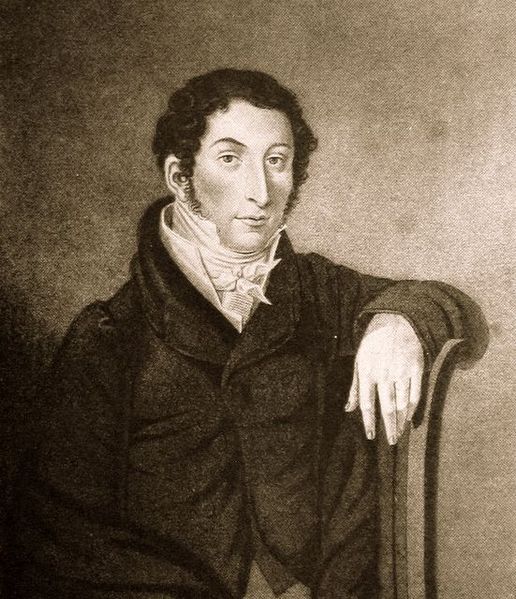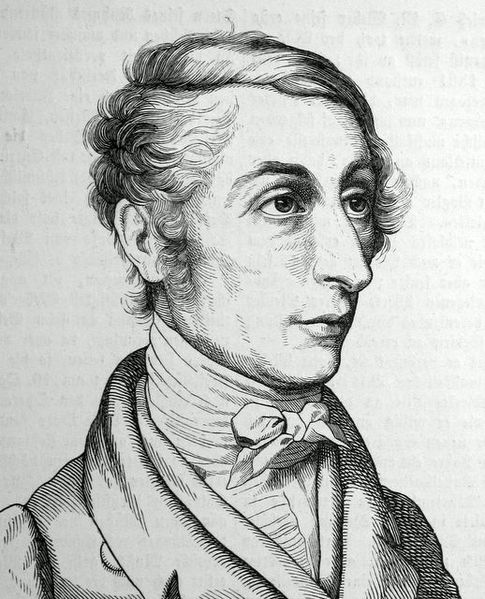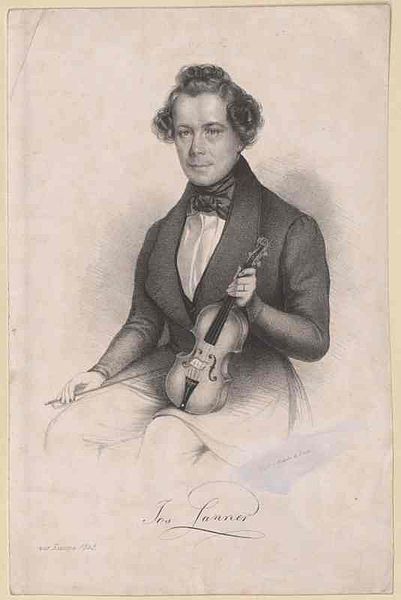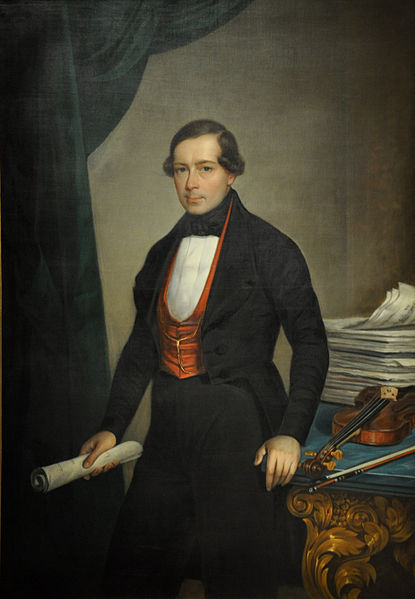<Back to Index>
- Composer Carl Maria Friedrich Ernst von Weber, 1786
- Composer Joseph Lanner, 1801
PAGE SPONSOR



Carl Maria Friedrich Ernst von Weber (18 – 19 November 1786 – 4 – 5 June 1826) was a German composer, conductor, pianist, guitarist and critic, one of the first significant composers of the Romantic school.
Weber's operas Der Freischütz, Euryanthe and Oberon greatly influenced the development of the Romantic opera in Germany. Der Freischütz came to be regarded as the first German "nationalist" opera, Euryanthe developed the Leitmotiv technique to a hitherto - unprecedented degree, while Oberon anticipated Mendelssohn's music for A Midsummer Night's Dream and, at the same time, revealed Weber's lifelong interest in the music of non - Western cultures. This interest was first manifested in Weber's incidental music for Schiller's translation of Gozzi's Turandot, for which he used a Chinese melody, making him the first Western composer to use an Asian tune that was not of the pseudo - Turkish kind popularized by Mozart and others.
A brilliant pianist himself, Weber composed four sonatas, two concertos and the Konzertstück (Concert Piece) in F minor, which influenced composers such as Chopin, Liszt and Mendelssohn. The Konzertstück provided a new model for the one - movement concerto in several contrasting sections (such as Liszt's, who often played the work), and was acknowledged by Stravinsky as the model for his Capriccio for Piano and Orchestra. Weber's shorter piano pieces, such as the Invitation to the Dance, was later orchestrated by Berlioz, while his Polacca Brillante was later orchestrated by Liszt.
Weber compositions for woodwind instruments occupy an important place in the musical repertoire. His compositions for the clarinet, which include two concertos, a concertino, a quintet and a duo concertante, are regularly performed today. His Concertino for Horn and Orchestra requires the performer to simultaneously produce two notes by humming while playing — a technique known as multiphonics.His Bassoon Concerto and the Andante e Rondo ungarese (a reworking of a piece originally for viola and orchestra) are also popular with bassoonists.
Weber's contribution to vocal and choral music is also significant. His body of Catholic religious music was highly popular in 19th century Germany, and he composed one of the earliest song cycles, Die Temperamente beim Verluste der Geliebten (Four Temperaments on the Loss of a Lover). Weber was also notable as one of the first conductors to conduct without a piano or violin.
Weber's orchestration has also been highly praised and emulated by later generations of composers - Berlioz referred to him several times in his Treatise on Instrumentation while Debussy remarked that the sound of the Weber orchestra was obtained through the scrutiny of the soul of each instrument.
His operas influenced the work of later opera composers, especially in Germany, such as Marschner, Meyerbeer and Wagner, as well as several nationalist 19th century composers such as Glinka. Homage has been paid Weber by 20th century composers such as Debussy, Stravinsky, Mahler (who completed Weber's unfinished comic opera Die drei Pintos and made revisions of Euryanthe and Oberon) and Hindemith (composer of the popular Symphonic Metamorphosis of Themes by Carl Maria von Weber).
Weber also wrote music journalism and was interested in folksong, and learned lithography to engrave his own works.
Weber was born in Eutin, Holstein, the eldest of the three children of Franz Anton von Weber and his second wife, Genovefa Brenner, a Viennese singer. The "von" was an affectation; Franz Anton von Weber was not actual aristocracy. Franz Anton began his career as a military officer in the service of the Duchy of Holstein, and after being fired, went on to hold a number of musical directorships. In 1787 Franz Anton went on to Hamburg where he founded a theatrical company.
Franz Anton's brother Fridolin married Cäcilia Weber and had four musical daughters, Josepha, Aloysia, Constanze and Sophie, all of whom became notable singers. Wolfgang Amadeus Mozart attempted to woo Aloysia, composing several pieces for her. But after she rejected his advances, Mozart went on to marry Constanze.
A
gifted violinist, Franz Anton had ambitions of turning Carl into a
child prodigy like Franz's nephew - by - marriage, Mozart. Carl was born
with a congenital hip disease and did not begin to walk until he was
four. But by then, he was already a capable singer and pianist.
Weber's father gave him a comprehensive education, which was however interrupted by the family's constant moves. In 1796, Weber continued his musical education in Hildburghausen, where he was instructed by the oboist Johann Peter Heuschkel.
On 13 March 1798, Weber's mother died of tuberculosis. That same year, Weber went to Salzburg to study with Michael Haydn, the younger brother of Joseph Haydn, who agreed to teach Carl free of charge. Later that year, Weber traveled to Munich to study with the singer Johann Evangelist Wallishauser and organist J.N. Kalcher.
1798 also saw the twelve year old Weber's first published work, six fughettas for piano, published in Leipzig. Other compositions of that period, among them a mass, and his first opera, Die Macht der Liebe und des Weins (The Power of Love and Wine), are lost; but a set of Variations for the Pianoforte was later lithographed by Weber himself, under the guidance of Alois Senefelder, the inventor of the process.
In 1800, the family moved to Freiberg, in Saxony, where Weber, then 14 years old, wrote an opera called Das stumme Waldmädchen (The Silent Forest Maiden), which was produced at the Freiberg theater. It was later performed in Vienna, Prague and St. Petersburg. The young Weber also began to publish articles as a music critic, for example in the Leipziger Neue Zeitung in 1801.
In 1801, the family returned to Salzburg, where Weber resumed his studies with Michael Haydn. He later continued studying in Vienna with Georg Joseph Vogler, known as Abbé Vogler, founder of three important music schools (in Mannheim, Stockholm, and Darmstadt); another famous pupil of Vogler was Giacomo Meyerbeer, who became a close friend of Weber.
In 1803, Weber's opera, Peter Schmoll und seine Nachbarn (Peter Schmoll and his Neighbors) was produced in Augsburg, and gave Weber his first success as a popular composer.
Vogler, impressed by his pupil's talent, recommended him to the post of Director at the Opera in Breslau in 1806. Weber sought to reform the Opera by pensioning off older singers, expanding the orchestra, and tackling a more challenging repertoire. His attempts at reform were met with strong resistance from the musicians and the Breslau public. Weber's time at Breslau was further complicated one night when he accidentally ingested engraver's acid that his father had left stored in a wine bottle. Weber was found unconscious and took two months to recover. The incident permanently ruined his singing voice.
He left his post in Breslau in a fit of frustration and from 1807 to 1810, Weber served as private secretary to Duke Ludwig, brother of King Frederick I of Württemberg.
Weber's time in Württemberg was plagued with troubles. He fell
deeply into debt and had an ill fated affair with Margarethe Lang, a
singer at the opera. Furthermore, Weber's father Franz Anton
misappropriated a vast quantity of Duke Ludwig's money. Franz Anton and
Carl were charged with embezzlement and arrested on February 9, 1810.
Carl was in the middle of a rehearsal for his opera Silvana when
he was arrested and thrown in prison by order of the king. Though no
one doubted Carl's innocence, King Frederick I had grown tired of the
composer's pranks. After a summary trial, Carl and his father were
banished from Württemberg. Nevertheless, Carl remained prolific as a composer during this period, writing a quantity of religious music, mainly for the Catholic mass. This however earned him the hostility of reformers working for the re-establishment of traditional chant in liturgy.
In 1810, Weber visited several cities throughout Germany; from 1813 to 1816 he was director of the Opera in Prague; from 1816 to 1817 he worked in Berlin, and from 1817 onwards he was director of the prestigious Opera in Dresden, working hard to establish a German Opera, in reaction to the Italian Opera which had dominated the European music scene since the 18th century. On 4 November 1817, he married Caroline Brandt, a singer who created the title role of Silvana. In 1819, he wrote perhaps his most famous piano piece, Invitation to the Dance.
The successful premiere of Der Freischütz on 18 June 1821 in Berlin led to performances all over Europe. On the very morning of the premiere, Weber finished his Konzertstück in F minor for Piano and Orchestra, and he premiered it a week later.
In 1823, Weber composed the opera Euryanthe to a mediocre libretto, but containing much rich music, the overture of which in particular anticipates Richard Wagner. In 1824, Weber received an invitation from Covent Garden, London, to compose and produce Oberon, based on Christoph Martin Wieland's poem of the same name. Weber accepted the invitation, and in 1826 he traveled to England, to finish the work and conduct the premiere on 12 April.
Weber was already suffering from tuberculosis when he visited London; he died at the house of Sir George Smart during the night of 4–5 June 1826. Weber was 39 years old. He was buried in London, but 18 years later his remains were transferred to the family vault in Dresden. The eulogy at the reburial was performed by Wagner.
His unfinished opera Die drei Pintos (The Three Pintos) was originally given by Weber's widow to Giacomo Meyerbeer for completion; it was eventually completed by Gustav Mahler, who conducted the first performance in this form in Leipzig on 20 January 1888.
Weber's piano music all but disappeared from the repertoire. One possible
reason for this is that Weber had very large hands and delighted in
writing music that suited them. There
are several recordings of the major works for the solo piano (including
complete recordings of the piano sonatas and the shorter piano pieces,
by Garrick Ohlsson, Alexander Paley and others), and there are recordings of the individual sonatas by Claudio Arrau (1st Sonata), Alfred Brendel (2nd Sonata), Sviatoslav Richter (3rd Sonata) and Leon Fleisher (4th Sonata). The Invitation to the Dance, although better known in Berlioz's orchestration (as part of the ballet music for a Paris production of Der Freischütz), has long been played and recorded by pianists (e.g., Benno Moiseiwitsch [in Carl Tausig's arrangement]). Invitation to the Dance also served as the thematic basis for Benny Goodman's swing tune Let's Dance.


Joseph Lanner (12 April 1801, St. Ulrich in Vienna – 14 April 1843, Döbling near Vienna) was an Austrian dance music composer. He was best remembered as one of the earliest Viennese composers to reform the waltz from a simple peasant dance to something that even the highest society could enjoy, either as an accompaniment to the dance, or for the music's own sake. He was just as famous as his friend and musical rival Johann Strauss I, who was better known outside of Austria in their day because of his concert tours abroad, in particular, to France and England.
Lanner had a lesser known son, August Lanner, who was just as musically gifted and prodigious as his father. His daughter Katharina became a well known international ballet dancer, settling in London where she became an influential choreographer and teacher.
Largely self taught on the violin, Lanner joined a small string orchestra of Michael Pamer at about the same time as Johann Strauss I did, although he decided to venture into the music business himself and partnered with Karl and Johann Drahanek, forming a quartet that bore his name. The success of this string quartet led to its gradual expansion, and in 1824 Lanner was able to conduct a small string orchestra playing Viennese dance music. Such was the success of his orchestra that it was a regular feature in many Vienna carnivals, popularly known in the local dialect as the Fasching. It was in 1832 that Lanner allowed his soon - to - be rival Johann Strauss I to deputize in a second, smaller orchestra that was formed that year to meet the busy schedule of the Carnival activities.
Lanner was already gaining a reputation at the end of the 1825 Carnival season and Strauss I was frustrated at having to deputize when necessary and as a result, his works were not getting the recognition he thought they deserved. In the same year, Strauss I parted company with Lanner after a concert at one of the Viennese dance establishments, Zum Schwarzen Bock (The Black Ram). Although many press reports stated a furious encounter between the two composers including a rumor that Strauss forcibly departed the orchestra with a few of Lanner's talented musicians, these remained largely unsubstantiated as Lanner had earlier dedicated a waltz to Strauss entitled "Trennungs-Walzer" ("Separation Waltz"), Op. 19, which indicated a decent level of goodwill and respect for the craft of the two composers. Further, Lanner and Strauss I worked together often despite having severed their partnership and even gave a benefit concert for their former employer, Michael Pamer who was taken ill in 1826 at the same establishment where they separated. For their charity work Strauss and Lanner also accepted the honorary citizenship of Vienna in 1836 and jointly took the Citizen's Oath.
The music loving Viennese however were championing both of these two popular dance music composers, and individuals generally identified themselves as Lannerianer or Straussianer. In fact, it was believed that the ruling Habsburg dynasty was anxious to divert its Viennese populace from politics and the revolutionary ideas that were feverishly sweeping Europe, with many cities preparing to overthrow any unpopular monarch. The answer would be to distract the population with music and entertainment, and the musical positions that both Lanner and Strauss held were soon seen to be very important. Lanner himself was appointed to the coveted post of Musik - Direktor of the Redoutensäle in the Hofburg Imperial Palace of which his primary duties were to conduct concerts held in honor of the nobility and to compose new works for the Court orchestra.
Strauss' popularity soon overshadowed Lanner in the early 1840s. Strauss was eager to undertake extensive lucrative tours abroad including England, whereas Lanner held on in Vienna unconvinced that the other nationalities were prepared to listen to Viennese music. Lanner succumbed to a typhus infection that racked Vienna in 1843 and died on Good Friday, 14 April in the same year. The famous rivalry with Strauss I had ended; Lanner's death marked the beginning of a period where the Strauss family was to dominate the Viennese dance music scene for well over a half a century and concluded an era of interesting and exciting developments for the waltz and other popular dance music.
Among Lanner's more popular works are the "Pesther - Walzer", Op. 93, "Hofballtänze Walzer", Op. 161, "Die Werber" Waltz, Op. 103, "Die Romantiker" Waltz, Op. 167, and probably his best known work, "Die Schönbrunner" Walzer, Op. 200, probably the most famous of all waltzes before "The Blue Danube" by Johann Strauss II in the mid 1860s. Most of Lanner's waltzes were dedicated to members of the nobility as evidenced from the titles which was part of the nature of Lanner's position at that time. His "Styrian Dances" (Steyrische - Tänze), Op. 165, was also played occasionally at the Vienna New Year's Concert of the Vienna Philharmonic Orchestra.